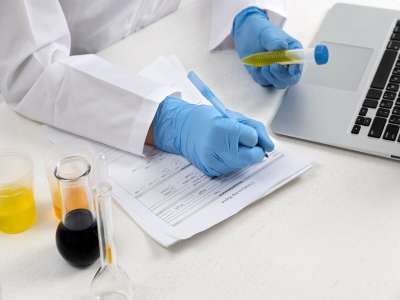17-Ketosteroids Level (24 hours urine): Clinical Significance, Precautions and Normal Values

17-Ketosteroids, a specific type of ketosteroids, are unique steroids that have a ketone (C=O) group replacing a hydrogen atom. This keto group is specifically attached to the 17th carbon atom of the steroid ring structure. They are formed when the body metabolizes male steroid sex hormones, known as androgens, and other hormones released by the adrenal glands in both males and females, and by the testes in males. Notable examples of 17-ketosteroids include androsterone, dehydroepiandrosterone, and estrone. These substances are typically found in normal human urine. However, an excess presence may indicate a tumor of the adrenal cortex or ovary. Thus, 17-ketosteroids play a crucial role in both the normal functioning and disease diagnosis of the human body.
Purpose of the test
The purpose of this examination is to evaluate the functionality of the adrenal cortex, as well as to monitor and assess adrenal tumors and hyperplasia.
Procedure for Collecting a Urine Sample for the 17-Ketosteroids Test
- A 24-hour urine sample is necessary for the 17-ketosteroids test. The urine is collected in a container that contains either one gram of boric acid or 6 ml of hydrochloric acid (HCl).
- The initial urine sample is discarded, and all subsequent urine is collected over a 24-hour period.
- The collected 24-hour urine sample is then transferred to a pathology laboratory for analysis.
The Role of Boric Acid in Urine Sample Collection
Boric acid is used in the collection of the urine sample because it transforms the urine into a bacteriostatic medium. This inhibits bacterial growth in the urine and preserves it for bacteriological examination.
Precautions to Take
Certain medications, such as aspirin, diuretics, antibiotics, birth control medication, and hormone therapy (e.g., Estrogen), may interfere with laboratory findings. Therefore, it is advisable to avoid these types of medication prior to preparing for the laboratory test.
Normal Values
- Males: 8-20 mg/24-hour
- Females: 6-15 mg/24-hour
- Elderly males > 70 years: 3-12 mg/24-hour
- Elderly females > 70 years: 3-13 mg/24-hour
- Infants: < 1 mg/24-hour
- 1 to 5 years: < 5 mg/24-hour
Reasons for the increased level of 17-ketosteroids in the 24-hour urine sample
- Pregnancy
- Stein-Leventhal syndrome
- Hyperpituitarism
- Ectopic ACTH-secreting tumors
- Administration of ACTH
- Cushing’s syndrome
- Congenital adrenal hyperplasia
- Testosterone secreting or androgen-secreting tumors of:
- Ectopic ACTH-secreting tumors
- Ovaries
- Testes
Reasons for the decreased level of 17-ketosteroids in the 24-hour urine sample
- Hypopituitarism
- Severe infections
- Klinefelter's syndrome
- Addison’s disease
- Severe stress
- Nephrosis
- Debilitating diseases
- Chronic diseases
- Castration
- Myxedema
- Drugs that can decrease the level of 17-ketosteroids include:
- Probenecid
- Estrogens
- Reserpine
- Thiazide diuretics
- Salicylates (prolonged use)
- Birth control pills
The significance of 17-ketosteroids for the layman
- The test is recommended for females who exhibit facial hair growth.
- The test is conducted to identify and elaborate on any abnormalities or disorders associated with the adrenal gland.
- Comment
- Posted by Dayyal Dg.